Our March Round Robin Blog asks the questions -- How do you self-edit your books before submitting or publishing?
2
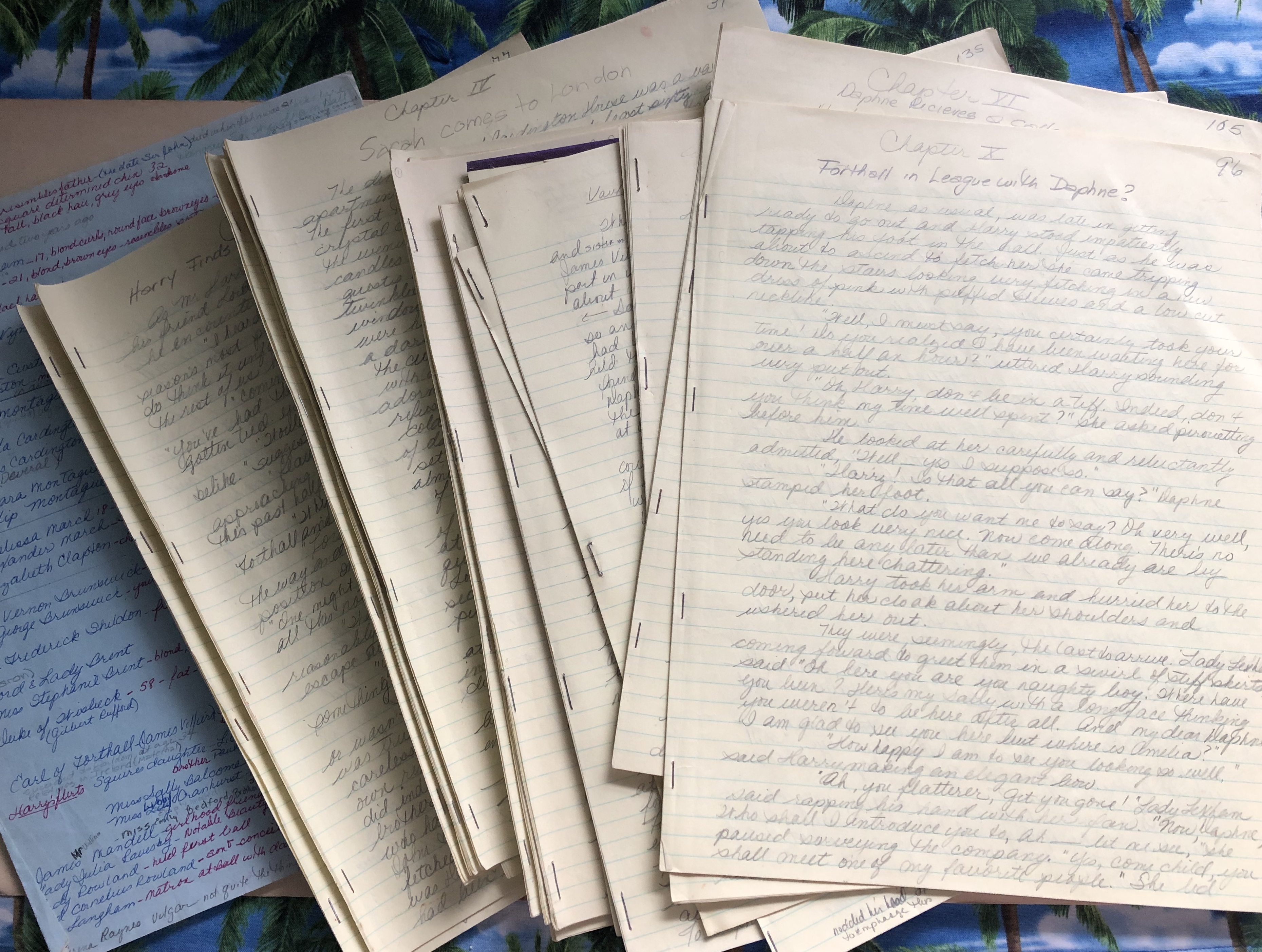 Back when I first began writing, it was on yellow lined paper with a pencil. Editing was done with the eraser and often with lots of notes in the margin, so many notes the document became difficult to read. Thankfully since then computers have arrived on the scene and they make it so much easier to edit, however one goes about it.
Back when I first began writing, it was on yellow lined paper with a pencil. Editing was done with the eraser and often with lots of notes in the margin, so many notes the document became difficult to read. Thankfully since then computers have arrived on the scene and they make it so much easier to edit, however one goes about it.
2
The other thing I did when I first began was to just write, and write, and write – NO editing at all. As another writer friend of mine often says, “The first draft is supposed to suck.” She’s a retired sailor, thus the colorful expression. As she and many other experienced authors will say, you can’t edit something that isn’t written and some folk, beginners especially, tend to second guess everything, get caught up in finding just the right word, or going back to fix something and end up stalling out with nothing ready to read. I’ve morphed from that beginning of writing everything that came into my head to a writer who tends to do some editing as I go, but save the big stuff for after the book is done. One of the reasons for this is I have a critique partner who reads each chapter as it is written and sends it back to me with comments and critique, and I usually fix those things before I dive into the next chapter. The other reason is that, even without a critique to consider, if I’ve been away from my characters and the action since I put the computer to sleep last night, or even longer, like several days, my mind and 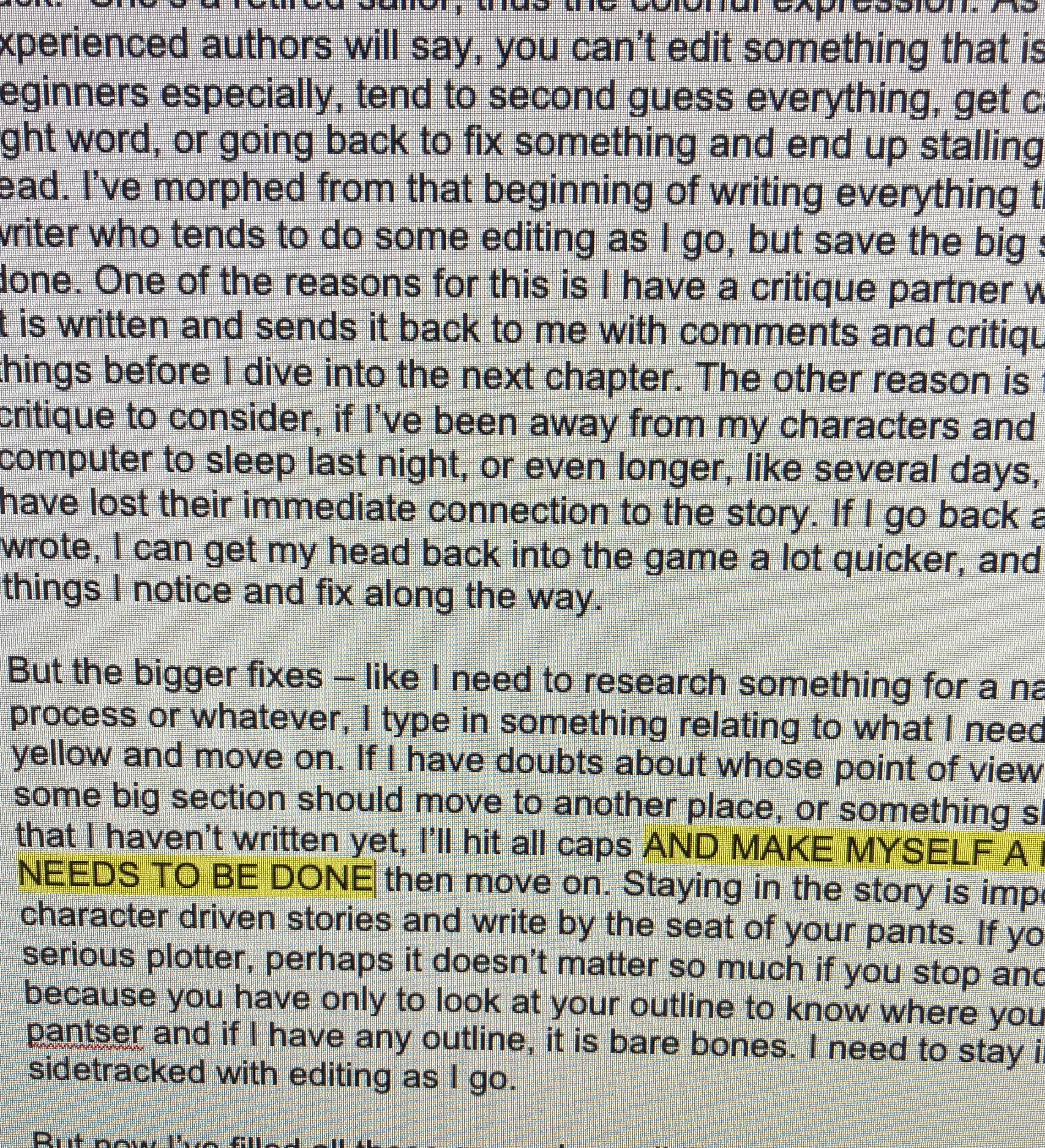 emotions have lost their immediate connection to the story. If I go back and read the last chapter I wrote, I can get my head back into the game a lot quicker, and there are always little things I notice and fix along the way.
emotions have lost their immediate connection to the story. If I go back and read the last chapter I wrote, I can get my head back into the game a lot quicker, and there are always little things I notice and fix along the way.
2
But the bigger fixes – like I need to research something for a name or a title or a process or whatever, I type in something relating to what I need, highlight it with bright yellow and move on. If I have doubts about whose point of view I should be in, or if some big section should move to another place, or something should happen here first that I haven’t written yet, I’ll hit all caps AND MAKE MYSELF A NOTE ABOUT WHAT NEEDS TO BE FIXED OR CHANGED then move on. Staying in the story is important when you write character driven stories and write by the seat of your pants. If you happen to be a serious plotter, perhaps it doesn’t matter so much if you stop and fix big issues, because you have only to look at your outline to 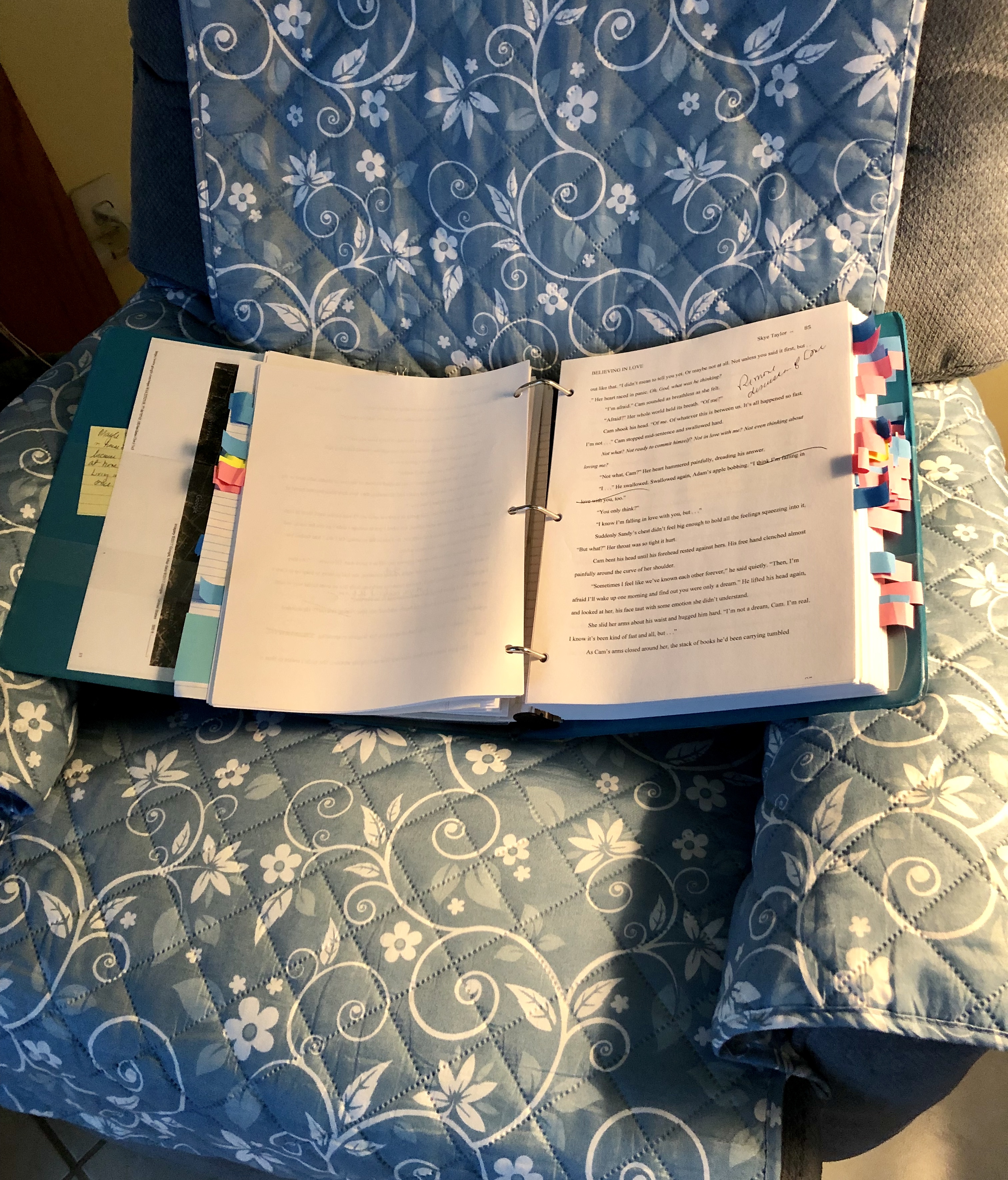 know where you’re going next. I’m a pantser and if I have any outline, it is bare bones. I need to stay in the story and not get sidetracked with editing as I go.
know where you’re going next. I’m a pantser and if I have any outline, it is bare bones. I need to stay in the story and not get sidetracked with editing as I go.
2
But now I’ve filled all those gaps, done all the research, figured out the POV and made the section consistent, and those ALL CAP places dealt with – NOW it’s time for my first major revision and edit. My personal method  for this is to print the entire manuscript out, punch it and put it in a big binder. Then I go find a comfortable chair and settle in. I have post-its at hand, sometimes in more than one color and a pen. If it happens to be romance, I have blue and pink flags and I go through the first time marking each POV section with a blue flag for my hero and a pink one for my heroine. Then, just by glancing at the edges I can easily see if they are both well represented throughout. I have one book with five points of view so there were five colored flags. Then I read just those sections for one POV character, skipping over the others to see if that character is acting and thinking consistently and that I haven’t missed any important changes in their attitude. And finally I read the whole thing through as if I were a beta reader, leaving notes on post-its along
for this is to print the entire manuscript out, punch it and put it in a big binder. Then I go find a comfortable chair and settle in. I have post-its at hand, sometimes in more than one color and a pen. If it happens to be romance, I have blue and pink flags and I go through the first time marking each POV section with a blue flag for my hero and a pink one for my heroine. Then, just by glancing at the edges I can easily see if they are both well represented throughout. I have one book with five points of view so there were five colored flags. Then I read just those sections for one POV character, skipping over the others to see if that character is acting and thinking consistently and that I haven’t missed any important changes in their attitude. And finally I read the whole thing through as if I were a beta reader, leaving notes on post-its along 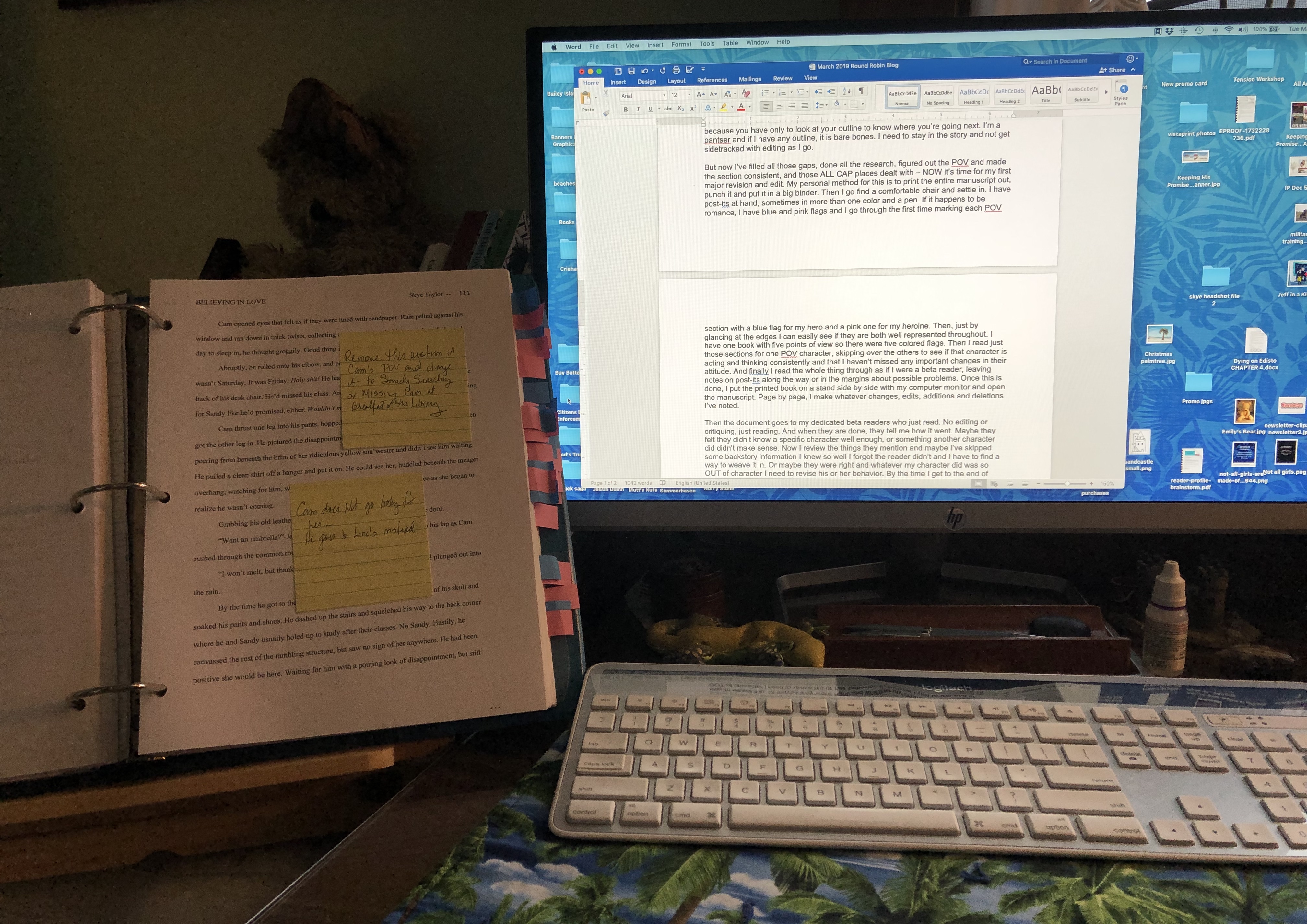 the way or in the margins about possible problems. Once this is done, I put the printed book on a stand side by side with my computer monitor and open the manuscript. Page by page, I make whatever changes, edits, additions and deletions I’ve noted.
the way or in the margins about possible problems. Once this is done, I put the printed book on a stand side by side with my computer monitor and open the manuscript. Page by page, I make whatever changes, edits, additions and deletions I’ve noted.
2
Then the document goes to my dedicated beta readers who just read. No editing or critiquing, just reading. And when they are done, they tell me how it went. Maybe they felt they didn’t know a specific character well enough, or something another character did didn’t make sense. Now I review the things they mention and maybe I’ve skipped some backstory information I knew so well I forgot the reader didn’t and I have to find a way to weave it in. Or maybe they were right and whatever my character did was so OUT of character I need to revise his or her behavior. By the time I get to the end of this, it’s time to have a copy editor or my acquiring editor at my publisher put eyes on it. I can fix whatever they find later, but my eyes have been looking at it for so long I no longer see any problems even when they are staring me in the face.
2
 So, that’s my process. My advice to other authors who ask is to be open to honest critique. A second pair of eyes sees things you no longer see and might have ideas or thoughts that strengthen your story. It is your story so you are also free to ignore advice, but at least listen and give the thoughts a fair hearing before dismissing. And enjoy the ride, wherever it takes you.
So, that’s my process. My advice to other authors who ask is to be open to honest critique. A second pair of eyes sees things you no longer see and might have ideas or thoughts that strengthen your story. It is your story so you are also free to ignore advice, but at least listen and give the thoughts a fair hearing before dismissing. And enjoy the ride, wherever it takes you.
2
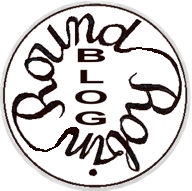 Check out these authors and see how they approach this must do task.
Check out these authors and see how they approach this must do task.
Diane Bator
Beverley Bateman
Connie Vines
Anne Stenhouse
A.J. Maguire
Dr. Bob Rich
Victoria Chatham
Helena Fairfax
Judith Copek
Rhobin L Courtright